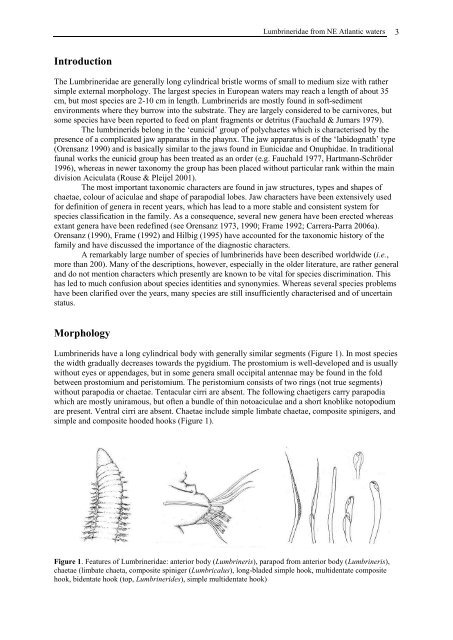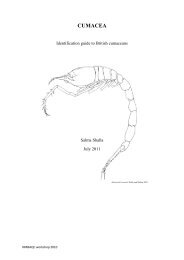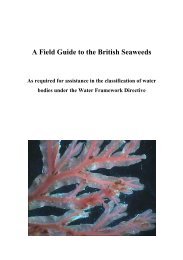Guide to identification of Lumbrineridae - NMBAQC
Guide to identification of Lumbrineridae - NMBAQC
Guide to identification of Lumbrineridae - NMBAQC
You also want an ePaper? Increase the reach of your titles
YUMPU automatically turns print PDFs into web optimized ePapers that Google loves.
Introduction<br />
<strong>Lumbrineridae</strong> from NE Atlantic waters<br />
The <strong>Lumbrineridae</strong> are generally long cylindrical bristle worms <strong>of</strong> small <strong>to</strong> medium size with rather<br />
simple external morphology. The largest species in European waters may reach a length <strong>of</strong> about 35<br />
cm, but most species are 2-10 cm in length. Lumbrinerids are mostly found in s<strong>of</strong>t-sediment<br />
environments where they burrow in<strong>to</strong> the substrate. They are largely considered <strong>to</strong> be carnivores, but<br />
some species have been reported <strong>to</strong> feed on plant fragments or detritus (Fauchald & Jumars 1979).<br />
The lumbrinerids belong in the ‘eunicid’ group <strong>of</strong> polychaetes which is characterised by the<br />
presence <strong>of</strong> a complicated jaw apparatus in the phaynx. The jaw apparatus is <strong>of</strong> the ‘labidognath’ type<br />
(Orensanz 1990) and is basically similar <strong>to</strong> the jaws found in Eunicidae and Onuphidae. In traditional<br />
faunal works the eunicid group has been treated as an order (e.g. Fauchald 1977, Hartmann-Schröder<br />
1996), whereas in newer taxonomy the group has been placed without particular rank within the main<br />
division Aciculata (Rouse & Pleijel 2001).<br />
The most important taxonomic characters are found in jaw structures, types and shapes <strong>of</strong><br />
chaetae, colour <strong>of</strong> aciculae and shape <strong>of</strong> parapodial lobes. Jaw characters have been extensively used<br />
for definition <strong>of</strong> genera in recent years, which has lead <strong>to</strong> a more stable and consistent system for<br />
species classification in the family. As a consequence, several new genera have been erected whereas<br />
extant genera have been redefined (see Orensanz 1973, 1990; Frame 1992; Carrera-Parra 2006a).<br />
Orensanz (1990), Frame (1992) and Hilbig (1995) have accounted for the taxonomic his<strong>to</strong>ry <strong>of</strong> the<br />
family and have discussed the importance <strong>of</strong> the diagnostic characters.<br />
A remarkably large number <strong>of</strong> species <strong>of</strong> lumbrinerids have been described worldwide (i.e.,<br />
more than 200). Many <strong>of</strong> the descriptions, however, especially in the older literature, are rather general<br />
and do not mention characters which presently are known <strong>to</strong> be vital for species discrimination. This<br />
has led <strong>to</strong> much confusion about species identities and synonymies. Whereas several species problems<br />
have been clarified over the years, many species are still insufficiently characterised and <strong>of</strong> uncertain<br />
status.<br />
Morphology<br />
Lumbrinerids have a long cylindrical body with generally similar segments (Figure 1). In most species<br />
the width gradually decreases <strong>to</strong>wards the pygidium. The pros<strong>to</strong>mium is well-developed and is usually<br />
without eyes or appendages, but in some genera small occipital antennae may be found in the fold<br />
between pros<strong>to</strong>mium and peris<strong>to</strong>mium. The peris<strong>to</strong>mium consists <strong>of</strong> two rings (not true segments)<br />
without parapodia or chaetae. Tentacular cirri are absent. The following chaetigers carry parapodia<br />
which are mostly uniramous, but <strong>of</strong>ten a bundle <strong>of</strong> thin no<strong>to</strong>aciculae and a short knoblike no<strong>to</strong>podium<br />
are present. Ventral cirri are absent. Chaetae include simple limbate chaetae, composite spinigers, and<br />
simple and composite hooded hooks (Figure 1).<br />
Figure 1. Features <strong>of</strong> <strong>Lumbrineridae</strong>: anterior body (Lumbrineris), parapod from anterior body (Lumbrineris),<br />
chaetae (limbate chaeta, composite spiniger (Lumbricalus), long-bladed simple hook, multidentate composite<br />
hook, bidentate hook (<strong>to</strong>p, Lumbrinerides), simple multidentate hook)<br />
3




